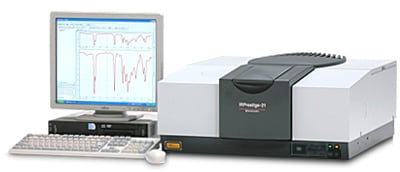(1) Hardware Validation; JIS; ASTM; Japanese Pharmacopoeia and European Pharmacopoeia
In this article, we will look at ways FTIR validation is performed.
The word "validate" can be taken to mean "enable". The process of having your parking ticket stamped at the cash register of your local department store after buying some products is an example of "validation". "Validate" has come to be used to refer to the process of performing the required inspection for a system, checking that it operates properly, and "enabling" it for use. In other words, to "validate" a system is to recognize the propriety of that system. Similarly, "validation" is used to mean "verification", "qualification", "confirmation", or "legitimization".
Here, we will look at FTIR hardware and software.

Hardware Validation
To perform "FTIR hardware validation" is to inspect an FTIR system and confirm that it is operating properly.
With dispersive IR, inspection (correction) was performed by measuring the spectra of polystyrene film and reading the peak wavenumber to correct wavenumber accuracy. With FTIR, the state of the system often manifests itself in power spectra and so checking the shape and size of power spectra is a relatively simple method that is used.
The method of checking the shape and size of power spectra is used with Shimadzu FTIR systems as part of daily inspection.
Several official bodies have issued standards related to the methods used to perform more detailed inspections of FTIR systems. Regulations are specified by industrial-standard bodies such as the American Society for Testing and Materials (ASTM) and the Japanese Industrial Standards (JIS, the Japanese version of ASTM) Committee and by publications such as the Japanese and European Pharmacopoeias.
Let us look at the kind of standards established by each body or publication.
JIS
Regulations are specified in JIS K0117 (General rules for infrared spectrophotometric analysis). Inspection methods are specified in 6.3 Calibration and Inspection Methods for Spectrophotometers. Points related to wavenumber (precision), 0 % transmittance, 100 % transmittance, linearity, resolution, and repeatability are specified. I will briefly describe the methods specified by JIS. JIS does not, however, give specific details on procedures or criteria.
Wavenumber (Accuracy)
This is obtained from the difference between the peak wavenumber(s) positions for a substance with a well-known peak wavenumber(s) position (e.g., atmospheric carbon dioxide, water vapor, polystyrene, ammonia, or indene) and the values indicated by the system.
0 % Transmittance
A sample that does not allow the transmission of light is measured in order to investigate the 0 % transmittance, namely, the error caused by stray light and secondary emission spectra.
100 % Transmittance
The 100 % transmittance is investigated by performing analysis without a sample and measuring the transmittance.
Linearity
A calibration curve for the absorbance and the concentration is created and the linearity of this curve is inspected.
Resolution
The resolution of absorbance peaks obtained using, for example, ammonia or atmospheric carbon dioxide, is investigated.
Reproducibility
A stable sample is measured at least twice within a short period and it is confirmed that the variation in the measurement values obtained for wavenumber and transmittance is within the prescribed range.
ASTM (American Society for Testing and Materials)
The ASTM standards are specified in E1421-99 Standard Practice for Describing and Measuring Performance of Fourier Transform Mid-Infrared (FT-MIR) Spectrometers; Level Zero and Level One Tests. With the ASTM standards, unlike the JIS standards and the pharmacopoeias described later, power spectra and spectrum of polystyrene films are measured and it is confirmed that there are no FTIR abnormalities or large changes over short and long periods. I will briefly describe the methods specified in the ASTM E1421-99 Level Zero tests.
Energy Spectrum Test - Changes in Power Spectra
Power spectra obtained in inspection are compared with reference data and the spectra are checked for changes over long periods.
One Hundred Percent Line Test - 100 % Line Changes Over Short Periods
100 %T line spectra are calculated for power spectra measured continuously in inspection and the spectra are checked for changes over short periods.
Polystyrene Test - Comparison of Polystyrene spectrum with Reference Data
Evaluation is performed using the differences between spectra obtained for polystyrene film in inspection and reference data.
The FTIR-8400S/IRPrestige-21 is equipped, as a standard feature, with a validation program that conforms to the ASTM E1421-99 Level Zero tests.
Japanese Pharmacopoeia and European Pharmacopoeia
The relevant specifications are given under Instrument and adjustment in Infrared Spectrophotometry in General Tests, in supplement 1 to the fourteenth edition of the Japanese Pharmacopoeia. Procedures and criteria are specified for four inspection items: resolution (resolving power), wave number precision, wave number reproducibility, and transmittance reproducibility. The specifications of supplement 1 to the fourteenth edition of the Japanese Pharmacopoeia have been brought in line with those of the European Pharmacopoeia (EP4.0).
The FTIR hardware validation methods used by Shimadzu are based on the Japanese Pharmacopoeia methods, which are aimed at the pharmaceutical industry and clearly specify procedures and standards, and not on the JIS/ASTM methods, which are aimed at industry and do not clearly specify procedures.
Pharmacopoeia of the United States of America
FTIR is mentioned in the Pharmacopoeia of the United States of America (USP). As shown below, however, it tells the reader to refer to manufacturers' instruction manuals for detailed instructions.
| Detailed instructions for operating spectrophotometers are supplied by manufacturers. To achieve significant and valid results, the operator of a spectrophotometer should be aware of its limitation and of potential sources of error and variation. The instruction manual should be followed closely on such matters as care, cleaning, and calibration of the instrument, and ...... |


